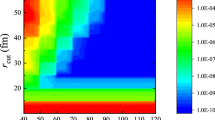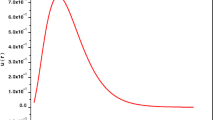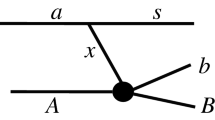Abstract
This paper is continuation of the previous review [Mukhamedzhanov and Blokhintsev, Eur. Phys. J. A 58, 29 (2022)] in which the ANC of a bound state was addressed. However, the ANC is important characteristics not only of bound states but also resonances. In this paper, the role of the ANCs in resonance processes is addressed. Among various topics considered here are Gamow–Siegert resonance wave functions for charged particles and their normalization, relationship between ANCs and resonance widths. Significant part is devoted to the R-matrix approach for resonance processes. The resonance wave functions, internal and external and their projections on the two-body channel are given. Important ingredients of the R-matrix method for resonance states are also discussed. Elastic resonance scatterings are analyzed and extended for subthreshold resonances. It is shown how the notion of the subthreshold resonance works in practical analysis. To this end, the \(^{13}\textrm{C}(\alpha ,\,n)^{16}\textrm{O}\) reaction, which is considered to be the main neutron supply to build up heavy elements from iron-peak seed nuclei in AGB stars, is analyzed. Important part of the review is analysis of the relationship between resonance width and ANC of mirror resonance and bound states using the Pinkston–Satchler equation and the Wronskian method. Practical examples are given. Among important parts of the theoretical research is the theory of transfer reactions populating resonance states. Comparative analysis of prior and post-form DWBA amplitudes shows that the prior form is preferable over the post form due to faster convergence over \(r_{nA}\). Calculations of the stripping to resonance reaction \({}^{16}\textrm{O}(d,\,p){}^{17}\textrm{O}(1d_{3/2})\) performed using the prior form of the CDCC method. A special attention is given to resonance astrophysical processes. Useful equations for internal and external radiative widths are given. Radiative capture through subthreshold resonance is considered. In particular, radiative capture reactions \({}^{11}\textrm{C}(p,\gamma ){}^{12}\textrm{N}\,\) and \(\,{}^{15}\textrm{N}(p,\gamma ){}^{16}\textrm{O}\,\) and the role of the ANC is addressed in detail.




















Similar content being viewed by others
Data Availibility Statement
This manuscript has no associated data or the data will not be deposited. [Authors’ comment: The relevant data are available from the author upon reasonable request.]
Notes
In what follows, we refer to this review as review [1].
Note that Zel’dovich’s exponential regulator \(e^{-\beta \,r^{2}}\) with \(\beta \rightarrow +0\), is a particular case of a more general Abel’s exponential regulator \(e^{-\beta \,r^{n}}\), where \(n \ge 1\).
We need to explicitly explain how to take complex conjugation of functions with complex arguments. Let u(k) be an analytic function in the complex plane with Taylor expansion

Then \(u^{*}(k) = \sum \limits _{n=0}^{\infty }\, a_{n}^{*}\,k^{n}\,\) and \(\,[u(k)]^{*}= \sum \limits _{n=0}^{\infty }\, a_{n}^{*}\,(k^{n})^{*}.\)
It is shown in [25] how to calculate \(X_{\tau }^{J_{F}\,M_{F}}\) in the shell-model approach.
It is noteworthy that the astrophysical factor is used in nuclear astrophysics to elucidate the difference between different approaches, which is not seen if one uses the cross-sections. However, in practical applications, cross-sections are used.
References
A.M. Mukhamedzhanov, L.D. Blokhintsev, Eur. Phys. J. A 58, 29 (2022)
G.Z. Gamow, Z. Phys. 51, 204 (1928)
A.J.F. Siegert, Phys. Rev. 56, 750 (1939)
N. Michel et al., Phys. Rev. Lett. 89, 042502 (2002)
N. Michel et al., Phys. Rev. C 67, 054311 (2003)
T. Berggren, Nucl. Phys. A 109, 265 (1968)
N. Michel et al., J. Phys. G 36, 013101 (2009)
N. Michel, M. Płoszajczak, Gamow Shell Model - The Unified Theory of Nuclear Structure and Reactions. Lecture Notes in Physics, vol. 983 (Springer, Cham, 2021)
K. Fossez et al., Phys. Rev. C 91, 034609 (2015)
G.X. Dong et al., Phys. Rev. C 105, 064608 (2022)
A.M. Mukhamedzhanov, M. Akin, Eur. Phys. J. A 37, 185 (2008)
Y.L. Mentkovsky, Nucl. Phys. 65, 673 (1965)
R.G. Newton, J. Math. Phys. 1, 319 (1960)
A. I. Baz, Y. B. Zeldovich, A. M. Perelomov, Scattering, Reactions and Decay in Nonrelativistic Quantum Mechanics, 2nd ed. (Nauka, Moscow, 1971) [English translation of 1st ed. (Jerusalem, 1969)]
I.M. Gel’fand, N.Y. Vilenkin, Generalized Functions, vol. 4 (Academic Press, New York, 1964)
K. Maurin, Generalized Eigenfunctions Expansions and Unitarity Representations of Topological Groups, (Polish Scientific Publishers, Warzaw, 1968). fourth edition, London (1980)
A.M. Mukhamedzhanov, A.S. Kadyrov, Few Body Syst. 60, 27 (2019)
A.M. Lane, R.G. Thomas, Rev. Mod. Phys. 30, 257 (1958)
E. Vogt, Rev. Modern Phys. 34, 723 (1962)
Descouvemont and Baye, Rep. Prog. Phys. 73, 036301 (2010)
F.C. Barker, Aust. J. Phys. 25, 341 (1972)
F.C. Barker, T. Kajino, Aust. J. Phys. 44, 369 (1991)
R.E. Azuma et al., Phys. Rev. C 81, 045805 (2010)
C.R. Brune, Phys. Rev. C 102, 034328 (2020)
C. Mahaux, H.A. Weidenmüller, Shell-Model Approach to Nuclear Reactions (North-Holland, Amsterdam, 1969)
C. Iliadis, Nuclear Physics of Stars (Wiley, Weinheim, 2007)
C.A. Bertulani, T. Kajino, Prog. Part. Nucl. Phys. 89, 56 (2016)
D.R. Tilley, H.R. Weller, C.M. Cheves, Nucl. Phys. A 564, 1 (1993)
M. Heil, R. Detwiler, R.E. Azuma et al., Phys. Rev. C 78, 025803 (2008)
T. Faestermann et al., Phys. Rev. C 92, 052802(R) (2015)
O. Tippella, M. LaCognata, Astrophys. J. 837, 41 (2017)
A.M. Mukhamedzhanov, Shubhchintak, C.A. Bertulani, Phys. Rev. C 93, 045805 (2016)
M.L. Avilla et al., Phys. Rev. C 91, 048801 (2015)
N.K. Timofeyuk, R.C. Johnson, A.M. Mukhamedzhanov, Phys. Rev. Lett. 91, 232501 (2003)
A.M. Mukhamedzhanov, Phys. Rev. C 99, 024311 (2019)
H.W. Drotleff et al., Astrophys. J. 414, 735 (1993)
W.T. Pinkston, G.R. Satchler, Nucl. Phys. 72, 641 (1965)
R.J. Philpott, W.T. Pinkston, G.R. Satchler, Nucl. Phys. A 119, 241 (1968)
K.M. Nollett, Phys. Rev. C 86, 044330 (2012)
N.K. Timofeyuk, P. Descouvemont, Phys. Rev. C 92, 034330 (2015)
P. Navrátil et al., Phys. Scr. 91, 053002 (2016)
N.K. Timofeyuk, Phys. Rev. C 84, 054313 (2011)
F. Ajzenberg-Selove, Nucl. Phys. A 523, 1 (1991)
Z.H. Liu et al., Phys. Rev. C 64, 034312 (2001)
N.K. Timofeyuk, P. Descouvemont, Phys. Rev. C 72, 064324 (2005)
T. Vertse, K.F. Pál, Z. Balogh, Comp. Phys. Comm. 27, 309 (1982)
L.G. Ixaru, M. Rizea, T. Vertse, Comp. Phys. Commun. 85, 217 (1995)
N. Michel, W. Nazarewicz, M. Ploszajczak, J. Okolowicz, Phys. Rev. C 67, 054311 (2003)
F.C. Barker, Phys. Rev. C 53, 1449 (1996)
F.C. Barker, Aust. J. Phys. 40, 307 (1987)
M. McCleskey, Phys. Rev. C 89, 044605 (2014)
V.Z. Goldberg et al., Phys. Rev. C 69, 031302(R) (2004)
H.T. Fortune, Phys. Rev. C 74, 054310 (2006)
A.M. Mukhamedzhanov et al., Phys. Rev. C 81, 054314 (2010)
G.H. Rawitscher, Phys. Rev. C 9, 2010 (1974)
M. Kamimura, M. Yahiro, Y. Iseri, H. Kameyama, Y. Sakuragi, M. Kawai, Progr. Theory Phys. Suppl. 89, 1 (1986)
N. Austern et al., Phys. Rep. 154, 125 (1987)
M. Yahiro et al., Progr. Theory Exp. Phys. 2012, 01A206 (2012)
R.C. Johnson, P.J.R. Soper, Phys. Rev. C 1, 976 (1970)
I.J. Thompson, Comput. Phys. Rep. 7, 167 (1987)
V.E. Bunakov, K.A. Gridnev, L.V. Krasnov, Phys. Lett. B 34, 27 (1971)
A.M. Mukhamedzhanov, A.S. Kadyrov, Phys. Rev. C 82, 051601(R) (2010)
A.E. Lovell, F.M. Nunes, Phys. Rev. C 97, 064612 (2018)
N.K. Timofeyuk, R.C. Johnson, Progr. Part Nucl. Phys. 111, 103738 (2020)
A.S. Kadyrov et al., Ann. Phys. 324, 1516 (2009)
A.M. Mukhamedzhanov, Phys. Rev. C 86, 044615 (2011)
J. Escher et al., Phys. Rev. C 89, 054605 (2014)
I.J. Thompson, F.M. Nunes, Nuclear Reactions for Astrophysics (Cambridge University Press, Cambridge, 2009)
A.M. Mukhamedzhanov et al., Phys. Rev. C 90, 034604 (2014)
M.D. Cooper, W.F. Hornyak, P.G. Roos, Nucl. Phys. A 218, 249 (1974)
H. A. Bethe, C. L. Critchfield, Phys. Rev 54, 248 and 862 (1938)
H. A. Bethe, Phys. Rev. 55, 103 and 434 (1939)
R.J. Holt et al., Phys. Rev. C 18, 1962 (1978)
A.M. Mukhamedzhanov, M. La Cognata, V. Kroha, Phys. Rev. C 83, 044604 (2011)
A.M. Mukhamedzhanov, D.Y. Pang, Phys. Rev. C 92, 014625 (2015)
M. Wiescher et al., Astrophys. J. 343, 352 (1989)
X. Tang et al., Phys. Rev. C 67, 015804 (2003)
A. Lefebvre et al., Nucl. Phys. A 592, 69 (1995)
T. Minemura et al., RIKEN Accel. Prog. Rep. A35, (2002)
P. Descouvemont, Nucl. Phys. A 646, 261 (1999)
C. Rolfs, W.S. Rodney, M.S. Shapiro, H. Winkler, Nucl. Phys. A 241, 460 (1975)
A.M. Mukhamedzhanov et al., Phys. Rev. C 73, 035806 (2006)
A.M. Mukhamedzhanov et al., Phys. Rev. C 78, 015804 (2008)
Rolfs, W.S. Rodney, Nucl. Phys. A 235, 450 (1974)
D.F. Hebbard, Nucl. Phys. 15, 289 (1960)
F.C. Barker, Phys. Rev. C 78, 044611 (2008)
D. Bemmerer et al., Phys. Rev. Lett. 97, 122502 (2006)
D. Bemmerer et al., J. Phys. G: Nucl. Phys. 36, 045202 (2009)
P.J. LeBlanc et al., Phys. Rev. C 82, 055804 (2010)
M. La Cognata, V.Z. Goldberg, A.M. Mukhamedzhanov, C. Spitaleri, R.E. Tribble, Phys. Rev. C 80, 012801(R) (2009)
J. Aguilar, J.M. Combes, Commun. Math. Phys. 22, 269 (1971)
E. Balslev, J.M. Combes, Commun. Math. Phys. 22, 280 (1971)
B. Simon, Commun. Math. Phys. 27, 1 (1972)
B. Simon, Ann. Math. 97, 247 (1973)
B. Gyarmati, A.T. Kruppa, Phys. Rev. C 34, 95 (1986)
Acknowledgements
The author acknowledges that this material is based upon work supported by the US DOE National Nuclear Security Administration, under Award Number DENA0003841 and DOE Grant No. DE-FG02-93ER40773. The author also thanks Nelya Nabieva for technical assistance.
Author information
Authors and Affiliations
Corresponding author
Additional information
Communicated by Nicolas Alamanos.
Appendices
Appendices
Appendix A: Rigged Hilbert space
A rigged Hilbert space is the so-called Gel’fand triplet (Gelfand and Vilenkin [15], Maurin [16])
Here \(\mathcal{H}\) is the completion of a linear space \({\mathbf \Psi }\) with a norm defined as a scalar product. Completed linear space \(\,\mathcal{H}\,\) means that the Cauchy sequences converge in the norm topology. A linear space \(\mathcal{{{\textbf{G}}}} \) is the completion of \(\,{\mathbf \Psi }\,\) in the topology stronger than the norm topology, that is, \(\mathcal{{{\textbf{G}}}} \) is dense in \(\,\mathcal{H}.\,\) In other words, it means that every point of \(\mathcal{H}\) either belongs to \(\mathcal{{{\textbf{G}}}}\) or is a limit point of \(\mathcal{{{\textbf{G}}}}\). The topology of the space \(\mathcal{{{\textbf{G}}}} \) is more stronger then the norm topology because the operators corresponding to the observables are continuous while in the norm topology of \(\mathcal{H}\) are not necessarily continuous. Thus \(\mathcal{{{\textbf{G}}}} \) is a subspace of \(\mathcal{H}\). \(\mathcal{H}^{\dagger }\) and \(\,\mathcal{{{\textbf{G}}}} ^{\dagger }\) are spaces of antilinear functionals over the spaces \(\mathcal{{{\textbf{G}}}} \) and \(\mathcal{H}\). While \(\mathcal{H}= \mathcal{H}^{\dagger }\) the space \(\,\mathcal{{{\textbf{G}}}} ^{\dagger }\,\) contains eigenvalues belonging to the continuous spectrum and complex eigenvalues. Adding \(\mathcal{{{\textbf{G}}}} ^{\dagger }\) allows us to deal with resonances. Gamow–Siegert states, which represent the generalized eigenvectors with the complex eigenvalues \(E_{R}= E_{0}- i\,\Gamma /2\), do not belong to the Hilbert state \(\mathcal{H}\). They describe decaying (irreversable) states in the time-dependent formalism and contain diverging asymptotic in the coordinate space and, hence, do not belong to the norm topology. The norm definition of the Gamow–Siegert eigenfunctions reguires a generalization. In a nutshell, to determine the norm of such vectors we need to introduce a regulator. The proof that such generalized norms can be defined for potentials with the Coulomb tail is given in Sect. 2.3.
Appendix B: Normallization of Gamow–Siegert wave functions
We prove here that Zel’dovich regularization procedure permits us to normalize the Gamow–Siegert resonance wave functions for Coulomb plus nuclear potentials:
Note that
converges for any \(R < \infty \).
It is important to show that the integral
converges for \(\beta \rightarrow +0\).
The introduction of the regularization factor \(\exp (-\beta \,r^{2})\) is necessary to provide the convergence of the normalization integral for \( r \rightarrow \infty \) which otherwise diverges because \(\exp (i\,k_{R}\,r)= \exp (i\,k_{0}\,r + k_{I}\,r)\). We split the integral (B.1) into two parts:
R is assumed to be large enough to approximate the Gamow–Siegert wave function by its leading asymptotic term (18) at \(r > R\).
The integral over a finite interval \(r \le R\) converges, and in this integral, we can take limit \(\beta \rightarrow +0\). We must prove that the second integral can also be determined in the limit \(\beta \rightarrow +0\). Taking into account that
where \(\alpha = Z_{a}\,Z_{A}\,e^{2}\,\mu \), and \(\lambda ,\,\delta > 0\), we get
For neutral particles there is only one exponentially diverging factor \( e^{2\,k_{I}\,r}\) (for \( r \rightarrow \infty \)) in the integrand. Zel’dovich’s normalization procedure works for \(k_{0} > k_{I}\). The presence of the oscillating exponential factor \(\exp (i\,2\,k_{0}\,r)\) is crucial for Zel’dovich’s regularization. However, for charged particles at complex momentum k we have an additional diverging factor in the integrand, \(r^{2\,\delta }\). We will show now that Zel’dovich’s method also works for the charged particles. To this end, one can rewrite Eq. (B.6) as the sum of two terms:
The first term in this equation converges, and we can take the limit \(\beta \rightarrow +0\) in this term. It is enough to consider the second term only. For \(\textrm{Re}k_{R}^{2} >0\)
Thus, we have shown that Zel’dovich’s regularization can be used to determine the norm of the Gamow–Siegert wave functions for charged particles. Zel’dovich’s regularization method is not unique, and other regularization techniques can be used. In particular, more general exponential regulator \(exp(-\beta \,r^{n}),\;n>2,\) can be used. It will allow one to include more resonances. Gamow–Siegert wave functions can also be normalized using the so-called complex scaling method (CSM).
Appendix C: Complex scaling method
Gamow–Siegert wave functions have another important advantage. Since asymptotically, they have only outgoing waves, we can use the complex scaling method (CSM) (Aguilar and Combes [91], Balslev and Combes [92], Simon [93, 94]). Note that this method is not applicable if the asymptotic wave function contains both incident and outgoing waves. We briefly discuss the CSM considering the two-body case. CSM (also called the complex-coordinate-rotation method) is based on the rotation of the radial coordinate in the complex r plane making a diverging radial wave function square integrable eigenfunction of the complex-scaled Hamiltonian.
This method consists of solving the Schrödinger equation on a ray in the first quadrant of the radial complex plane rather than on the real axis of the coordinate r. The axis rotation angle \(\theta \) (if we neglect the potential singularities) is limited by the angle defined by the resonance parameters, see below. It is important that the CSM can be applied to the case of charged particles. This is true only for the point-like Coulomb-potential, which behaves like 1/r or for the Coulomb potential of a diffuse sphere. An application of this method to resonances in nuclear reactions was presented by Gyarmati and Kruppa [95]. The numerical realization of this method is a rather complex one.
Let us consider the coordinate rotation operator (known also as complex scaling operator)
Then
and
Let k be the resonance momentum
where \(\nu = (1/2)\arctan (\frac{\Gamma }{2\,E_{0}})\) is the phase of \(k_{R}\). We have
and
Thus the critical angle of the radius rotation is \(\theta _{cr}= \nu = 1/2\arctan (\frac{\Gamma }{2\,E_{0}})\). For \(\theta > \theta _{cr},\,\) the exponential term \(\,\,e^{-|k_{R}|\,r\,sin[\theta -\nu ]}\,\) vanishes at \(r \rightarrow \infty \).
The term \(e^{-i\eta _{R}\,\ln (2\,k_{R}\,r\,e^{i\,\theta })}\), which represents the Coulomb correction to the asymptotic outgoing wave, can be reduced to
Hence the rotation of the radius in the complex plane generates in the Coulomb term \( e^{-i\eta _{R}\,\ln (2\,k_{R}\,r\,e^{i\,\theta })}\) a constant factor \(e^{\eta _{R}\,[\theta -\theta _{cr}]}.\,\) Hence we achieved what sought:
The asymptotic convergence of the complex-scaled outgoing waves allows one to normalize the Gamow–Siegert resonance wave function but we are not going into more detail about that.
Rights and permissions
Springer Nature or its licensor (e.g. a society or other partner) holds exclusive rights to this article under a publishing agreement with the author(s) or other rightsholder(s); author self-archiving of the accepted manuscript version of this article is solely governed by the terms of such publishing agreement and applicable law.
About this article
Cite this article
Mukhamedzhanov, A.M. Resonances in low-energy nuclear processes and nuclear astrophysics and asymptotic normalization coefficients: a review. Eur. Phys. J. A 59, 43 (2023). https://doi.org/10.1140/epja/s10050-023-00918-8
Received:
Accepted:
Published:
DOI: https://doi.org/10.1140/epja/s10050-023-00918-8





